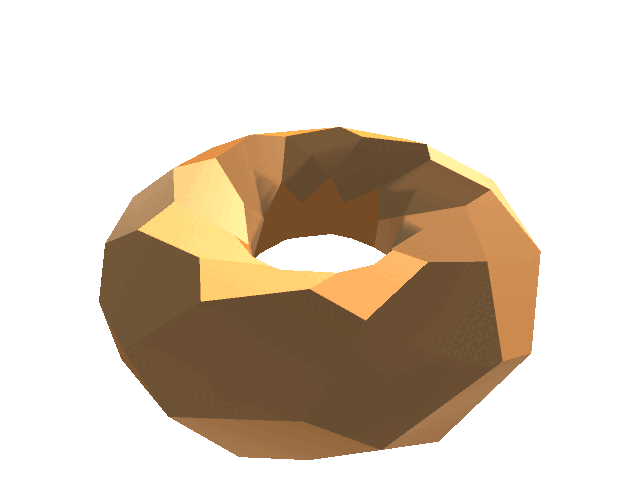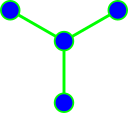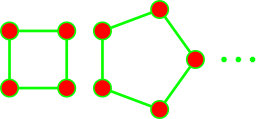Homological obstructions to existence of diagonalization algorithms for sparse matrices
BIMSA Topology Seminar
BIMSA/Zoom, May 16, 2024
Graphs and matrix shapes.
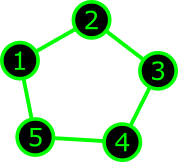 |
$\Rightarrow$ |
\[
\begin{pmatrix}
\ast & \ast & & & \ast\\
\ast & \ast & \ast & & \\
& \ast & \ast & \ast & \\
& & \ast & \ast & \ast \\
\ast & & & \ast & \ast
\end{pmatrix}
\]
|
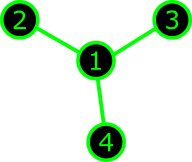 |
$\Rightarrow$ |
\[
\begin{pmatrix}
\ast & \ast & \ast & \ast \\
\ast & \ast & & \\
\ast & & \ast & \\
\ast & & & \ast
\end{pmatrix}
\]
|
-
$\lambda=(\lambda_1<\cdots<\lambda_n)$ : a simple spectrum.
-
$M_\lambda$ : the set of all matrices with spectrum $\lambda$.
-
$M_{\Gamma,\lambda}=M_\Gamma\cap M_\lambda$
: the set of all $\Gamma$-shaped matrices with spectrum $\lambda$.
-
If $\lambda$ is generic, then
$M_{\Gamma,\lambda}$ is a smooth closed manifold
(follows from Sard's lemma).
-
$\dim M_{\Gamma,\lambda}=2|E_\Gamma|$.
Graphs and matrix shapes.
We are interested in homological complexity of $M_{\Gamma,\lambda}$
depending on graph $\Gamma$.
Observations:
-
For all graphs $\Gamma$ on $n$ vertices we have $\chi(M_{\Gamma,\lambda})=n!$.
-
For some graphs $\Gamma$ we have $H^{odd}(M_{\Gamma,\lambda})=0$ and hence $\beta(M_{\Gamma,\lambda})=n!$.
-
For some graphs $\Gamma$ we have $H^{odd}(M_{\Gamma,\lambda})\neq0$ and hence $\beta(M_{\Gamma,\lambda})>n!$.
Main tool: toric topology
-
Unitary group $U(n)$ acts on $M_n$ by conjugation.
It preserves the spectrum.
-
Let $T\subset U(n)$ be the torus of diagonal matrices. We have induced $T$-action on $M_\lambda$.
This is a torus.
Move cursor to pick an element and act on a matrix!
|
$\circlearrowright$
|
|
|
|
[edit]
|
-
$T$-action on $M_\lambda$ preserves $\Gamma$-shape for any graph $\Gamma$.
-
Therefore, the torus $T$ acts on $M_{\Gamma,\lambda}$.
Torus actions. General notions:
-
$T$ : compact torus.
-
$T$ acts smoothly (and effectively) on a smooth manifold $X$.
-
$X^T$ : the set of $T$-fixed points . It is assumed finite and nonempty.
-
$X_T=X\times_TET$ : Borel construction;
-
$p\colon X_T\stackrel{X}{\to} BT$ : Serre fibration;
-
$H^*_T(X)=H^*(X_T)$ : equivariant cohomology module;
-
$E_2^{p,q}\cong H^p(BT)\otimes H^q(X)\Rightarrow H^{p+q}_T(X)$ :
Serre spectral sequence.
Definition: $X$ is called
equivariantly formal if its Serre spectral sequence
degenerates at $E_2$.
Torus actions. General notions:
-
$E_2^{p,q}\cong H^p(BT)\otimes H^q(X)\Rightarrow H^{p+q}_T(X)$ :
Serre spectral sequence.
Definition: $X$ is called
equivariantly formal if its Serre spectral sequence
degenerates at $E_2$.
Equivalently (fixed points are isolated):
Equivariant formality $\Leftrightarrow$ $H^{odd}(X)=0$.
Problem for today: which graphs $\Gamma$ give equivariantly formal manifolds
$M_{\Gamma,\lambda}$?
Examples: full matrices
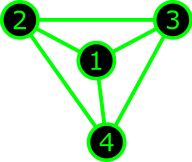 |
$\Rightarrow$ |
\[
\begin{pmatrix}
\ast & \ast & \ast & \ast \\
\ast & \ast & \ast & \ast \\
\ast & \ast & \ast & \ast \\
\ast & \ast & \ast & \ast
\end{pmatrix}
\]
|
| Full graph |
|
Full matrix |
-
Full graph corresponds to the manifold $M_\lambda$ itself.
-
$U(n)$ acts transitively on $M_\lambda$ with stabilizer $T^n$.
-
Hence $M_\lambda\cong U(n)/T=Fl_n$, the full flag variety.
-
It is equivariantly formal. $\beta(Fl_n)=n!$.
Examples: tridiagonal
 |
$\Rightarrow$ |
\[
\begin{pmatrix}
\ast & \ast & & \\
\ast & \ast & \ast & \\
& \ast & \ast & \ast \\
& & \ast & \ast
\end{pmatrix}
\]
|
| Path graph $\mathbb{I}_n$ |
|
Tridiagonal matrix |
-
Path graph corresponds to tridiagonal matrices.
-
The manifold $M_{\mathbb{I}_n,\lambda}$ was introduced and studied by
Tomei'84.
-
Tomei proved that $M_{\mathbb{I}_n,\lambda}/T$ is a
permutohedron.
-
In modern terminology, $M_{\mathbb{I}_n,\lambda}$ is a
quasitoric manifold over permutohedron.
-
$M_{\mathbb{I}_n,\lambda}$ is equivariantly formal. $\beta(M_{\mathbb{I}_n,\lambda})=n!$.
Examples: staircase
 |
$\Rightarrow$ |
\[
\begin{pmatrix}
\ast & \ast & \ast & & \\
\ast & \ast & \ast & \ast & \\
\ast & \ast & \ast & \ast & \\
& \ast & \ast & \ast & \ast \\
& & & \ast & \ast \\
\end{pmatrix}
\]
|
-
Spaces like $M_{\Gamma,\lambda}$ appeared in the literature
(de Mari, etc.)
-
A.-Buchtaber'21: $M_{\Gamma,\lambda}$ shares many common properties
with corresponding regular semisimple Hessenberg varieties. We called them
twins of Hessenberg varieties.
-
A.-Buchtaber'21: $M_{\Gamma,\lambda}$
admits even-dimensional cell structure. Morse theory is the key.
-
Hence $M_{\Gamma,\lambda}$ is equivariantly formal.
Examples: arrowhead
 |
$\Rightarrow$ |
\[
\begin{pmatrix}
\ast & \ast & \ast & \ast \\
\ast & \ast & & \\
\ast & & \ast & \\
\ast & & & \ast
\end{pmatrix}
\]
|
| The claw graph $St_3$ |
|
Arrowhead matrix |
-
Torus action has complexity $0$. This is a torus manifold.
|
Theorem (Gal-Januszkiewicz, unpublished):
$M_{St_3,\lambda}/T$ is a solid torus with boundary subdivided into hexagons.
Masuda-Panov theorem: if $T^n$ effectively acts on
$M^{2n}$ with isolated fixed points, then equivariant formality implies $M^{2n}/T^n$ is acyclic.
|
|
-
A.-Buchstaber'21:
\[
\beta(M_{St_3,\lambda})=(1,1,12,0,12,1,1).
\]
-
It follows directly that $M_{St_n,\lambda}$ is not formal for $n\geqslant 3$.
Examples: periodic tridiagonal
 |
$\Rightarrow$ |
\[
\begin{pmatrix}
\ast & \ast & & & \ast\\
\ast & \ast & \ast & & \\
& \ast & \ast & \ast & \\
& & \ast & \ast & \ast \\
\ast & & & \ast & \ast
\end{pmatrix}
\]
|
| Cycle graph $Cy_n$ |
|
Periodic tridiag-
onal matrix |
-
Torus action of complexity $1$ in general position.
-
A.'20: $M_{Cy_n,\lambda}$
is not equivariantly formal for $n\geqslant 4$.
-
$\pi_1(M_{Cy_n,\lambda})\cong \mathbb{Z}^{n-3}$ (if $M_{Cy_n,\lambda}$ is smooth).
A.-Masuda'19: If there is an equivariantly formal torus action of complexity $1$
in general position on $X$, then $X/T$ is a homology sphere.
A.'18: $M_{Cy_n,\lambda}/T\cong S^4\times T^{n-3}$.
Indifference graphs:
Which graphs correspond to staircase matrices?
Definition: Graph $\Gamma$ is called
indifference graph if it is the intersection graph
of some collection of unit intervals on a line $\mathbb{R}$.
Also called unit interval graphs or
proper interval graphs.
Theorem (Mertzios'08):
$\Gamma$ represents staircase matrices $\Leftrightarrow$ $\Gamma$ is an indifference graph.
 |
$\Rightarrow$ |
\[
\begin{pmatrix}
\ast & \ast & \ast & & \\
\ast & \ast & \ast & \ast & \\
\ast & \ast & \ast & \ast & \\
& \ast & \ast & \ast & \ast \\
& & & \ast & \ast \\
\end{pmatrix}
\]
|
Warning:
Some matrices are staircase even if they don't look so:
 |
$\Rightarrow$ |
\[
\begin{pmatrix}
\ast & \ast & \ast \\
\ast & \ast & \\
\ast & & \ast
\end{pmatrix}
\]
|
|
 |
$\Rightarrow$ |
\[
\begin{pmatrix}
\ast & \ast & \\
\ast & \ast & \ast \\
& \ast & \ast
\end{pmatrix}
\]
|
Spaces $M_{\Gamma,\lambda}$ in these two cases are homeomorphic. The space depends only on a graph.
Result
Preliminaries: For any graph $\Gamma$ on $n$ vertices we have:
-
$T$-action on $M_{\Gamma,\lambda}$ has $n!$ many fixed points,
-
therefore $\beta_{even}-\beta_{odd}=\chi(M_{\Gamma,\lambda})=n!$,
-
therefore $\beta(M_{\Gamma,\lambda})\geqslant n!$.
Theorem:
The following conditions are equivalent:
-
$\Gamma$ is an indifference graph,
-
$M_{\Gamma,\lambda}$ is equivariantly formal;
-
$\beta(M_{\Gamma,\lambda})=n!$.
Topological complexity
Corollary:
If $\Gamma$ is not indifference, then
-
$\beta(M_{\Gamma,\lambda})>n!$, hence
-
any Morse-Smale flow or cascade on $M_{\Gamma,\lambda}$ has $>n!$ stationary points.
This gives an applied math intuition behind this result.
QR-algorithm
| Original matrix: |
|
|
At each step we represent a matrix $A_i$ as $Q\cdot R$
and take $A_{i+1}=R\cdot Q$. Here $Q$ is orgthogonal, $R$ is upper triangular.
|
Fill in the matrix above.
Press "u" to upload.
Press "q" to make QR step.
After 0 iterations:
|
| * |
* |
* |
* |
| * |
* |
* |
* |
| * |
* |
* |
* |
| * |
* |
* |
* |
|
QR-algorithm
-
QR-algorithm preserves spectrum and symmetricity.
-
It has $n!$ limit points (diagonal matrices with spectrum at the diagonal).
-
It is a Morse-Smale cascade on $M_\lambda$.
-
QR-algorithm preserves staircase shape.
-
It is a flow on $M_{\Gamma,\lambda}$ for indifference graph $\Gamma$.
Toda flow
-
Continuous version of QR-algorithm.
-
Same properties.
-
Honest gradient flow of a Morse function.
Nonexistence of algorithms
-
Assume a Morse-Smale flow (or cascade) exists on $M_{\Gamma,\lambda}$
-
such that its stationary points are only diagonal matrices.
-
In this case we say that the flow defines a Morse-Smale
type asymptotical diagonalization algorithm.
-
Since there are $n!$ many stationary points, we have
-
$\beta(M_{\Gamma,\lambda})\leqslant n!$ by Morse inequality.
Corollary:
If $\Gamma$ is not indifference, then no Morse-Smale type diagonalization algorithm exists for
$\Gamma$-shaped matrices.
How we prove Main Theorem:
We need to prove
"$\Gamma$ is not an indifference graph"
$\Rightarrow$ "$M_{\Gamma,\lambda}$ is not formal".
Lemma: If $M_{\Gamma,\lambda}$ is formal and
$\Gamma'$ is an induced subgraph of $\Gamma$, then $M_{\Gamma',\lambda}$ is also formal.

|

|
|
Induced
|
Not induced
|
Conclusion: we only need to prove non-formality
for "minimal" non-indifference graphs.
How we prove:
Conclusion: we only need to prove non-formality
for this list of forbidden graphs.
-
Claw $St_3$ and Holes $Cy_n$ ($n\geqslant 4$)
are already studied: non-formality of $M_{\Gamma,\lambda}$ is proved.
-
It remains to prove non-formality for
$Net$ and $Sun$.
To do this, we developed a general approach.
Face submanifolds:
-
Let $H\subseteq T$ be a connected subgroup.
Definition:
-
A connected component of the fixed point manifold $X^H$
is called an invariant submanifold.
-
If an invariant submanifold intersects $X^T$,
it is called a face submanifold.
-
The rank of an invariant (face) submanifold $Y$ is the dimension of generic
toric orbit on $Y$.
-
Face submanifolds are partially ordered by inclusion.
-
Fixed points = face submanifolds of rank $0$.
-
The greatest face submanifold is $X$ itself. It has rank $\dim T$.
Definition:
The poset of all face submanifolds is denoted $S(X)$. It is graded by ranks.
Face poset and formality
-
$S(X)_r$ : the $r$-skeleton, the poset
of all face submanifolds of rank $\leqslant r$.
-
We say a $T$-action has GKM type if every face submanifold of rank $1$ is a $2$-sphere.
-
Every $M_{\Gamma,\lambda}$ has GKM type.
-
Let $|S|$ denote the geometrical realization of a poset $S$.
Theorem (A.-Masuda-Solomadin'22):
Assume a $T$-action on $X$ is equivariantly formal and $\dim T\geqslant 4$.
Then for any $r\geqslant 4$ we have
\[
\tilde{H}^i(|S(X)_r|)=0 \quad\text{ for }\quad i\leq 3.
\]
In other words, the skeleton
$|S(X)_r|$ is $3$-acyclic.
Cases:
|
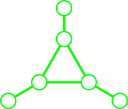
|
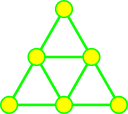
|
$Net$
|
$Sun$
|
|
\[
\begin{pmatrix}
\ast & \ast & \ast & \ast & & \\
\ast & \ast & \ast & & \ast & \\
\ast & \ast & \ast & & & \ast \\
\ast & & & \ast & & \\
& \ast & & & \ast & \\
& & \ast & & & \ast \\
\end{pmatrix},
\begin{pmatrix}
\ast & \ast & \ast & & \ast & \ast \\
\ast & \ast & \ast & \ast & & \ast\\
\ast & \ast & \ast & \ast & \ast & \\
& \ast & \ast & \ast & & \\
\ast& & \ast & & \ast & \\
\ast & \ast & & & & \ast \\
\end{pmatrix}
\]
|
$M_{Net,\lambda}$ is $12$-dim manifold with $5$-dim torus action.
$M_{Sun,\lambda}$ is $18$-dim with $5$-dim torus action.
It is impossible to compute $H^{odd}$ of these spaces...
...however, we can describe the poset $S(M_{\Gamma,\lambda})$ and compute its homology
in low degrees.
So we did the following:
-
A.-Buchstaber'22: Described the poset
$S(M_{\Gamma,\lambda})$.
It is isomorphic to
the core
of the graphicahedron of $\Gamma$.
-
Assumption $M_{Net,\lambda}$ and $M_{Sun,\lambda}$ are formal, implies
$|S(M_{Net,\lambda})_4|$ and $|S(M_{Sun,\lambda})_4|$ are 3-acyclic.
-
So we tried to check, whether this is true.
Cases:
|

|

|
$Net$
|
$Sun$
|
|
\[
\begin{pmatrix}
\ast & \ast & \ast & \ast & & \\
\ast & \ast & \ast & & \ast & \\
\ast & \ast & \ast & & & \ast \\
\ast & & & \ast & & \\
& \ast & & & \ast & \\
& & \ast & & & \ast \\
\end{pmatrix},
\begin{pmatrix}
\ast & \ast & \ast & & \ast & \ast \\
\ast & \ast & \ast & \ast & & \ast\\
\ast & \ast & \ast & \ast & \ast & \\
& \ast & \ast & \ast & & \\
\ast& & \ast & & \ast & \\
\ast & \ast & & & & \ast \\
\end{pmatrix}
\]
|
We wrote a script in Sage, and computed:
Theorem (A.-Sorokin'22): $|S(M_{Net,\lambda})_4|$ and
$|S(M_{Sun,\lambda})_4|$ are 2-acyclic.
But $\beta_3(|S(M_{Net,\lambda})_4|)=5$
and $\beta_3(|S(M_{Sun,\lambda})_4|)=5$.
*Coefficients in $\mathbb{Z}_2$.
Since face posets are not $3$-acyclic, manifolds are not equivariantly formal.
This finalizes the proof of the main theorem.
Thank you for your attention!
Our papers related to this work:
-
A.A.Ayzenberg, V.M.Buchstaber, Manifolds of isospectral arrow matrices, Sbornik: Mathematics 212:5 (2021), 3-36.
[link]
-
A.A.Ayzenberg, V.M.Buchstaber, Manifolds of isospectral matrices and Hessenberg varieties, IMRN 2021:21 (2021), 16671-16692.
[link]
-
A.Ayzenberg, Space of isospectral periodic tridiagonal matrices, Alg. and Geom. Topology 20 (2020), 2957-2994.
[link]
-
A.Ayzenberg, M.Masuda, Orbit spaces of equivariantly formal torus actions, Transformation Groups, 2023, preprint.
[link]
-
A.Ayzenberg, V.Cherepanov, Matroids in toric topology, 2022,
[preprint].
-
A.Ayzenberg, M.Masuda, G.Solomadin, How is a graph not like a manifold?, to appear in Sbornik: Mathematics
[link].
-
A.Ayzenberg, V.Buchstaber, Cluster-permutohedra and submanifolds of flag varieties with torus actions, IMRN 2023
[link].
-
A.Ayzenberg, K.Sorokin, Topological approach to diagonalization algorithms, 2022, preprint.
[preprint].
Technical reference:
An extended version of this presentation is available
here.

|
Source code and instructions on usage lie on
Github.

|















